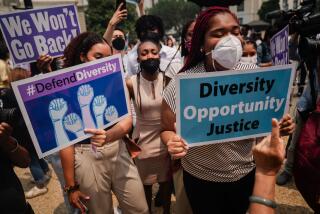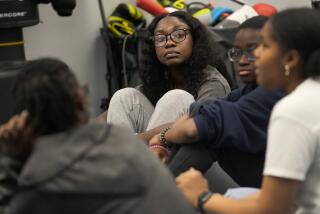Feminists and Civil Rights Activists Praise Court Ruling
News of Wednesday’s Supreme Court decision upholding affirmative action for women by permitting gender to be taken into account in promotion plans, hit feminists and civil rights activists like a blast of fresh air.
“I’m sitting here with a grin on my face,” Maureen Kindel, president of the Board of Public Works, said from a meeting of the board. Already familiar with the case, she sounded elated as she spoke in a hushed voice.
“This decision definitely applies to Public Works. We sit here with only one bureau head that I have been able to appoint. I’ve not been able to make any (female) high-level appointments. I see in front of me the faces of some of our really energetic young professional sanitation engineers--females--who should really take heart with this decision.”
The 6-3 decision, written by Justice William J. Brennan, concerned the case of the Santa Clara County (Calif.) Transportation Agency’s 1980 promotion of Diane Joyce, a white woman, to road dispatcher above Paul Johnson, a white man. Both had experience as road yard clerks, but Johnson, in protesting, claimed he was more qualified because he scored two points higher on an oral examination and also was the three examiners’ unanimous choice among the nine candidates.
The agency, implementing its 1978 voluntary affirmative action plan to promote women, minorities and handicapped workers, took Joyce’s sex into account in the promotion. At the time, none of the 238 skilled craft positions was held by a woman.
The court had been asked to strike down affirmative action programs on the grounds they violated the constitutional rights of other employees. The court ruled that the Santa Clara plan did not, that no absolute bar to the promotion of males had been created, that no quotas had been established.
“It’s a wonderful victory, especially in view of the recent backlash and erosion of laws and their enforcement in sex discrimination in employment and education,” feminist writer and activist Betty Friedan said.
“The Reagan Administration has gutted so much. It’s very important that the Supreme Court so decisively ruled to encourage employers to take affirmative action. It certainly does not take a microscope to conclude that if not one of more than 200 jobs was held by a woman there was a pattern of discrimination. It’s clear that promoting a woman despite a few decimal points in test scores is a sound step.”
Nobody contacted had anything bad to say about the content of the decision, nor were delighted reactions qualified by reservations. There was, however, a concern that the media and the public would somehow manage to wrongly perceive it as as case of less-qualified women and minority members being promoted over more-qualified men.
Judith Resnik, professor of law at USC Law Center, called Wednesday’s decision “tremendous.” Resnik was reached as she was preparing to argue another case involving women before the Supreme Court on Monday, the Board of Directors of Rotary International vs. Rotary Club of Duarte.
Concern Over Perceptions
In stressing that it was not a court-ordered remedy but a ruling on a voluntary action, she did, however, express a concern over a news account that said the Court upheld promotion of less-qualified women.
“What the court is saying,” Resnik said, “is that if the record shows an insignificant difference, what you really have are two equally qualified applicants. It recognizes as a fact of contemporary society that women and minorities are not properly represented in many areas of the work force.
“The law is not putting up a barricade to any group. This is not quotas. This is permitting variations. All members of society who are committed to moving away from discrimination should welcome this flexible approach.”
In Washington, Barry Goldstein, assistant counsel for the NAACP’s Legal Defense Fund, was strong and specific in his appraisal.
“It’s the most important of the Supreme Court affirmative action decisions in employment,” he said.
Equally Qualified
The specifics of the case were interesting, he said, especially with regard to the question of who was more qualified. Joyce was one of nine people qualified for the position, Goldstein said. The civil service rules permitted the director to hire any one of the nine. The ranking of the nine numerically came when three interviewers gave Johnson a two-point lead over Joyce.
“These were the same men,” Goldstein said of the supervisors, “who had been selecting and promoting candidates in the recent past, in a department where all 238 positions were filled by men.”
Interestingly enough, Goldstein said, Joyce had run-ins with two of the three doing the ratings and one of them called her “a rabble-rousing skirt-wearing person.”
“A lot of what this decision does is make sure that lower-level supervisors open up opportunities for women and minorities,” Goldstein said, describing it as an attempt to break a logjam.
“To do that, we’re going to have to take gender and race into account for a certain amount of time. It’s a great opinion, and the people of Santa Clara deserve everyone’s thanks.”
Overcomes Fears
Cynthia Marano, executive director of the Washington-based Wider Opportunities for Women, a private nonprofit national women’s employment organization involved in training and advocacy, said the decision would have a direct impact on the work of her organization.
Her organization trains women in non-traditional occupations, she said, and a different decision or ruling would have meant a halting of progress.
Specifically, she said, the decision serves to overcome the fears or excuses of those employers who avoided promotions because “they felt they would be found to be in reverse discrimination. Because of the challenge of (the Johnson) lawsuit and some of the findings of the Justice Department, it appeared that women would not be protected by Title VII (of the Civil Rights Act of 1964).
“It’s one of the best victories women have had in many years. Basically, the decision has empowered employers to use their affirmative action plans.”
Susan Rose, executive director of the Los Angeles City Commission on the Status of Women, reached as she was about to begin the commission’s second day of hearings on women in the media, saw the decision as “encouraging for women in very difficult economic times to have the Supreme Court affirm equal opportunity for women.”
“Perhaps this is a trend for the court,” she said, referring to the Court’s recent decision protecting women’s job status during maternity leave.
“Is it really a trend?” Rose asked herself rhetorically. “I don’t know. But it sure is a good sign for us.”
More to Read
Sign up for Essential California
The most important California stories and recommendations in your inbox every morning.
You may occasionally receive promotional content from the Los Angeles Times.










